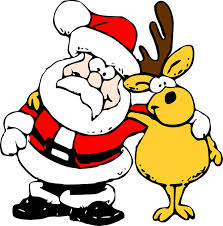Around the holiday season people all around the world come across traditions that are blindly followed, but rarely do they stop to wonder how these traditions came about. From Christmas trees to reindeer, every holiday icons has a back story.

When you think of Santa, you tend to think of his mode of transportation.
Santa’s Reindeer
The image of Santa flying around with his eight reindeer is widely known around the world. What isn’t known is why Santa’s sleigh is guided by reindeer specifically. The image of Santa and his reindeer stems from literature, mainly William Gilley’s A New Year’s Present, published in 1821.
In Gilley’s writing, he states “Old Santeclaus with much delight; His reindeer drives this frosty night; O’er chimneytops, and tracks of snow; To bring his yearly gifts to you.” This image of reindeer was the first instance in which reindeer were associated with Santa Claus. However, when Gilley was interviewed in 1822 and asked to explain where he got his idea of reindeer, he vaguely answered that a friend, whose name is not revealed, claimed that up north in the Arctic there lived animals which much resembled reindeer, and being that the Arctic is where Santa Claus lives, reindeer seemed to be the appropriate animal to pull his sleigh full of toys.
Rudolph
Rudolph came about over a century after his other reindeer friends. Rudolph the Red-Nosed Reindeer was originally written in 1939 by a department store copywriter named Robert L. May. The department store had been buying and giving away coloring books to children around the Christmas season, and they decided that it would be cheaper if they created their own coloring books, which is where May came in. The first Christmas season it was produced, nearly 2.4 million copies were sold.
It is believed that Rudolph the Red-Nosed Reindeer was based on May’s childhood, claiming that he was bullied as a child for being small and weak. Over 70 years later, Rudolph remains one of Santa’s most popular reindeer.
Christmas Stockings
As the legend has it, a nobleman went through a depression after the loss of his wife, and because of this, he spent his money frivolously. His daughters were then left without dowries. When St. Nicholas heard about the daughters’ misfortunes, he quickly came to help. Riding a white horse in order to remain anonymous, he threw three pouches of gold down the chimney, which were caught by stockings that the three daughters had left to dry by the fireplace, and thus the Christmas stocking tradition came about.

Commonly known, the candy cane is one of the most popular Christmas candies.
The Candy Cane
In the 17th century sweets and treats were often made to celebrate Christmas – the candy cane was no exception. The candy cane is shaped as a cane in order to represent a shepherd’s crook. Candy canes were often given out to children during Christmas ceremonies, such as church and nativity scenes, in order to keep them quiet.
More modern explanations of the candy cane explain that the white represents Christ’s purity, the red represents the blood he shed, and the three red stripes represents the Holy Trinity. While there is no proof that these representations were intentional, they are widely believed nonetheless.

Hanging during Christmas time, mistletoe is a staple during the Christmas season.
Mistletoe
The commonality of mistletoe during winter time came about 200 years before the birth of Christ. Priests during this time period adored the mistletoe plant because it remained green all year round, even through the harsh winters.
Ancient Celtics believed that the mistletoe plant was magical, containing mysterious healing powers. They also believed that the mistletoe could cure poison, infertility, and ward off evil spirits.
In Roman times, the mistletoe was also symbolic of peace. It was believed that if two enemies were to meet underneath the mistletoe, they would put aside their grudges and their weapons and embrace.
Scandinavians believed that the mistletoe was representative of Frigga, the goddess of love. This correlation would explain the tradition of kissing beneath the mistletoe. Those who kiss underneath the mistletoe are believed to be promised a year of happiness and good luck.
Christmas Trees
Today’s tradition of the Christmas tree can be traced back to the 8th century, when St. Boniface attempted to convert Germanic tribes into Christians. The tribes had the tradition of decorating oak trees for the winter solstice. When St. Boniface cut down the tribes most highly regarded oak tree, which was their center of worship, and in its place a fir tree grew. The tribes and St. Boniface regarded this fir tree as a symbol of Christianity, and they began to decorate it every Christmas season.

Sporting his rosy cheeks and white beard, Santa is ready to deliver his presents.
Santa Claus
Santa Claus, who may be known by many names, is the most popular Christmas tradition, being the face of Christmas itself. What many people don’t know is that Santa Claus is based on a real person – Saint Nicholas.
Saint Nicholas, born in the year 270 in Turkey, was a dedicated Christian, serving God in every way that he could. His most popular Christian act was giving all that he had to the poor. Eventually, he became Bishop of Myra, and was known for his compassion towards children. After his death, he became regarded as the patron saint of children and Saint Nicholas Day came about, being celebrated on December 6th.
Now, Saint Nicholas, or Santa Claus, is known for watching boys’ and girls’ behavior throughout the world, and bringing toys to all the good little girls and boys on Christmas Day.
12 Days of Christmas
The 12 days of Christmas are representative of the 12 days between Jesus’s birth and the epiphany. Jesus Christ was born on December 25th, Christmas day, and the epiphany occurred on January 6th. The epiphany, also known as Three Kings Day, is the day in which Three Kings came to the stable where Jesus was born in order to give him three gifts – frankincense, myrrh, and gold. The 12 days of Christmas are now regarded as a time of peace and reconciliation, in which people all over the world settle their differences and celebrate the Christmas season.
Wrapping it up
Christmas is celebrated all over the world, along with the many traditions that come along with it. Although many people do not consider the history of the traditions that they are unknowingly carrying out, there is a story behind all of them, and each story is what makes them so special.















